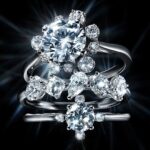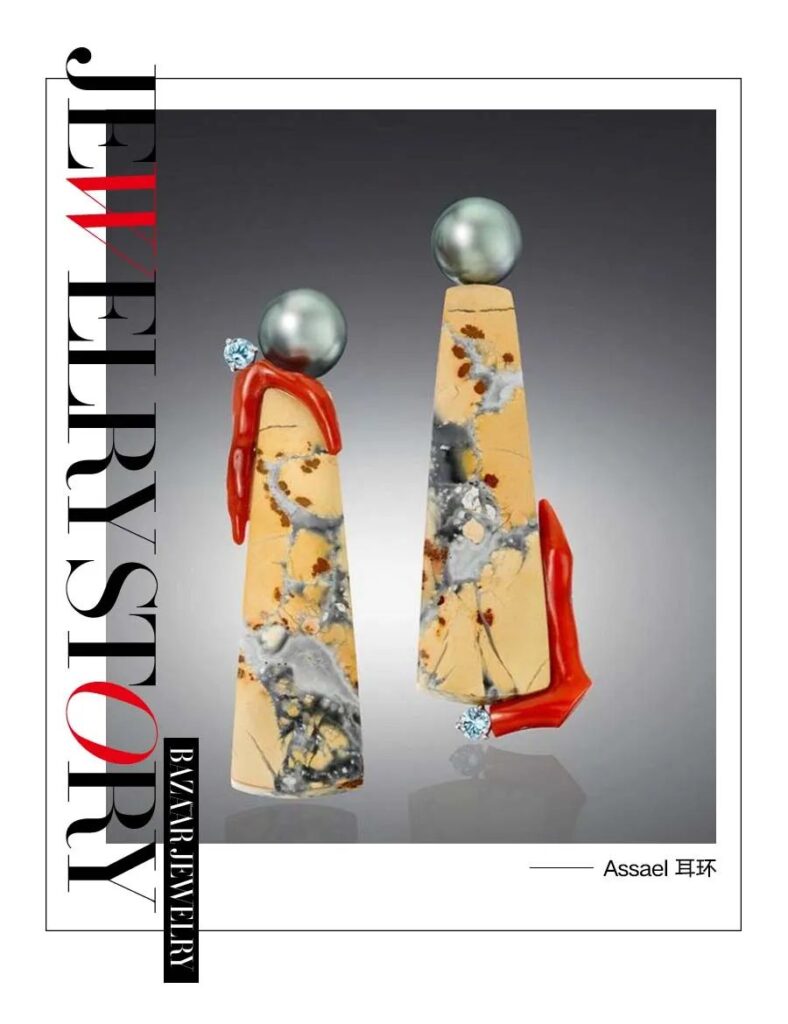
Maison Boucheron has once again introduced creative material combinations, with obsidian, marble, and sand appearing in the new works of Creative Director Claire Choisne, stunning audiences once more.
This has become a jewelry trend, with more designers focusing on creativity rather than material value. In their eyes, any material that can realize the exquisite vision in their minds is perfect, giving many lesser-known gemstones or other natural materials the opportunity to shine in the high jewelry world.
These jewelry artists freely combine traditional gemstones with various novel materials in unconventional ways. You’ll discover that seemingly unremarkable, niche materials can be elevated to “star status.” The harmonious and beautiful imagery makes you feel that these masters must possess a “Midas touch,” instantly transforming previously unremarkable “nobodies” in the gemstone world into dazzling, highly valuable pieces!
Some jewelry designers are particularly sensitive to color, believing that as long as the colors match, any materials can be combined. They often go to great lengths to find matching gemstones in pursuit of this ultimate color fusion. Beyond rare gemstones, there are many other materials, and if all else fails, they can even create their own. The bottom line is that this mix-and-match approach must be visually stunning at first glance!
Assael, a brand specializing in pearls, is no longer the conservative, niche brand solely focused on pearl quality since welcoming Creative Director Peggy Grosz. This designer has an innate sensitivity to color and excels at mixing and matching. She can quickly combine colors, patterns, and textures, bringing together completely unexpected materials.
Moreover, pearls, especially Tahitian pearls, are delicate, multi-colored gemstones, and Peggy Grosz can perfectly capture every hue and find their “perfect match.”
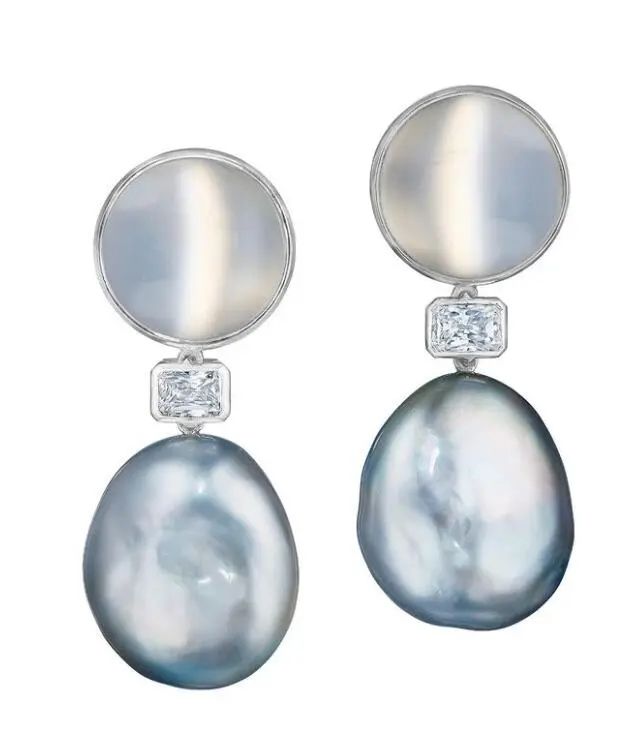
Tahitian baroque pearls, cat’s eye gemstones
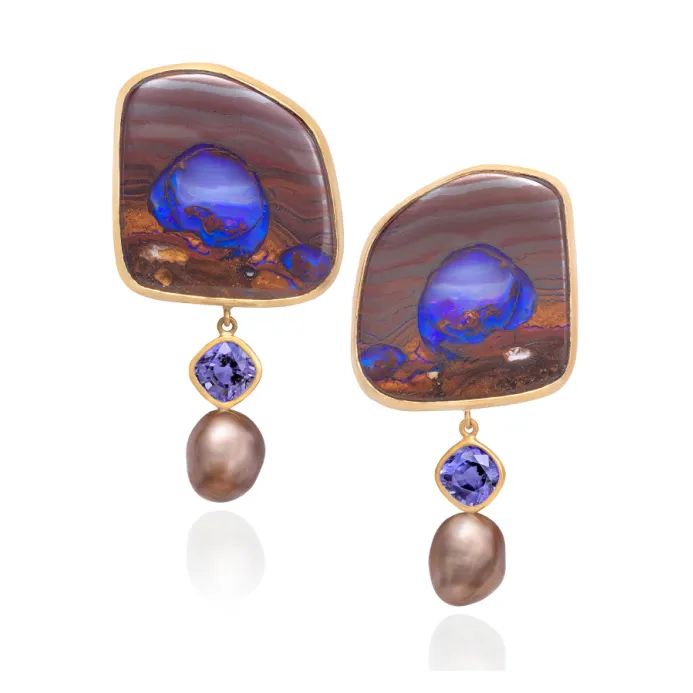
Boulder opal, Tahitian baroque pearls, tanzanite
Indeed, the gemstones she selects are often unfamiliar to most people. For example, these earrings are composed of Tahitian pearls and opalised fossil wood, connected and brightened by small aquamarines.
The color tones of the two main stones perfectly complement each other, with the patterns of the opalised fossil wood breaking up the monotony of the gray-blue color. Note that she uses opalised fossil wood, not the opal that has been popular in high jewelry circles in recent years.
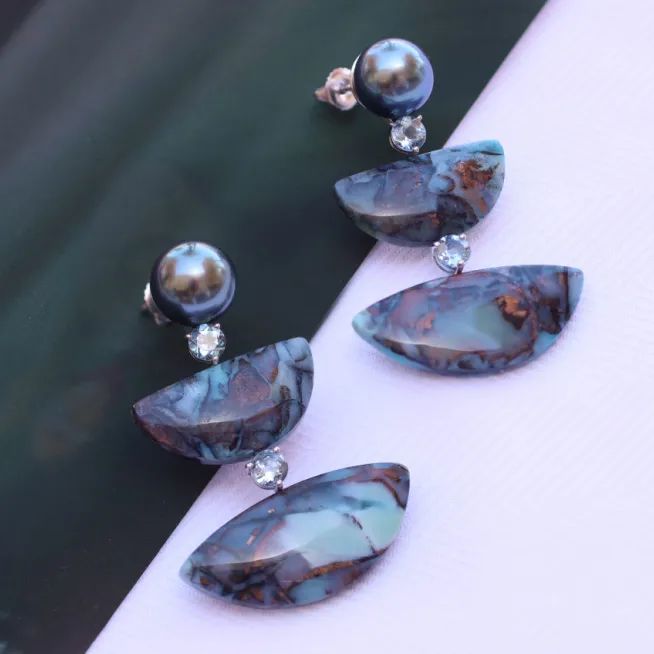
Opalised fossil wood, aquamarine, Tahitian pearls
Opalised fossil wood is a type of fossil opal, a rare material that takes at least 100 million years to form. The English term “Opalised Fossil” refers to fossils that have been replaced by opal.
It forms when silica (the main component of opal) settles on the surface of certain animals, plants, or minerals, replacing their original material. This fossil can originate from animals, plants, and minerals; Peggy Grosz uses a type of opalised fossil from trees.
Although it doesn’t have the play-of-color effect like opal, its colors and patterns have been refined by time, making it mysterious, understated, and unique. It truly complements the silvery blue-purple-grey tones of Tahitian pearls perfectly.
This isn’t the only fossil Peggy Grosz uses; she has also selected many petrified woods with unique patterns and colors to match the diverse pearl family. For example, she pairs cypress petrified wood, which resembles butterfly wings, with Tahitian pearls of the same hue, or uses the transitional colors of conifer petrified wood to accentuate the brilliance of golden South Sea pearls.
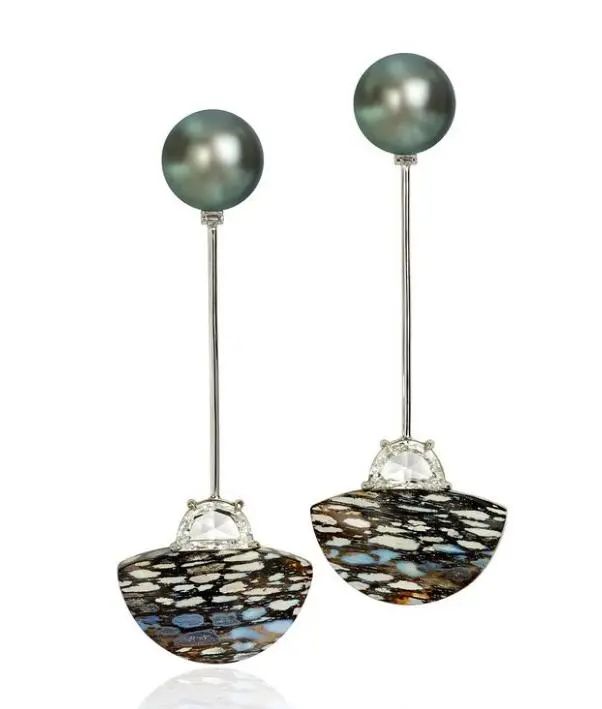
Tahitian pearls, cypress petrified wood, diamonds

Golden South Sea pearls, conifer petrified wood
Peggy Grosz also finds many rare and special gemstones to pair with pearls. For instance, tiger iron, a unique gemstone combination found only in Western Australia. This gemstone consists of layers of banded hematite, red jasper, and tiger’s eye, formed about 2.2 billion years ago. The rich color variations of this gemstone perfectly complement the silver tones of Tahitian pearls and the vibrant red of Sardinian coral.

Coral, tiger iron, Tahitian pearls
The sacred and luxurious golden South Sea pearls require gemstones that can hold their own. She chose pyrite metamorphic rock, known as “fool’s gold.” It often appears in coal seams, creating a gold-speckled visual effect that pairs elegantly and nobly with golden pearls.
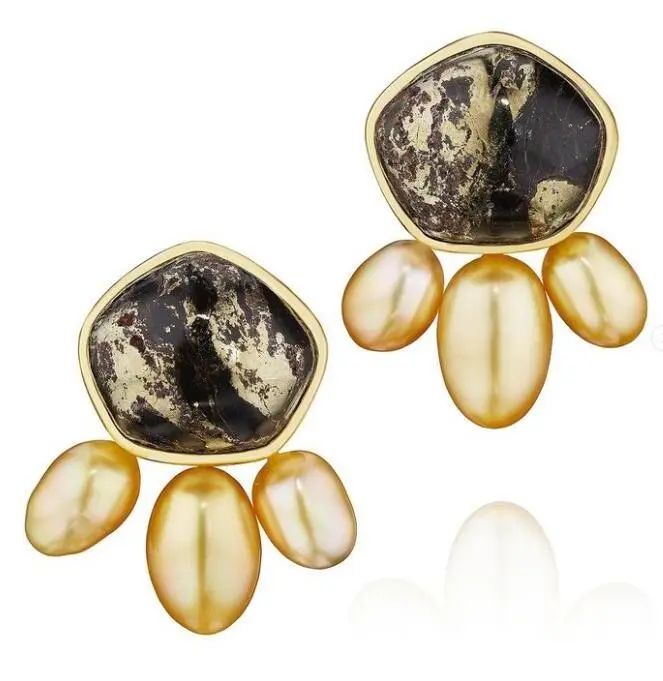
Golden South Sea baroque pearls, pyrite
Then there’s this ring featuring aquaprase as the main stone. Peggy Grosz discovered this gemstone at the Tucson show, and its soft colors, bright tones, and sea-like texture immediately inspired her creativity.
She ultimately surrounded it with a “pearl cloud” composed of South Sea pearls, white Akoya pearls, and true “dove-colored” Akoya pearls. She explains, “Because aquaprase has a lower hardness, it needs the protection of the ‘pearl cloud.’ This color combination reminds me of blue skies and white clouds, so this ring is called ‘Sky and Clouds.'”
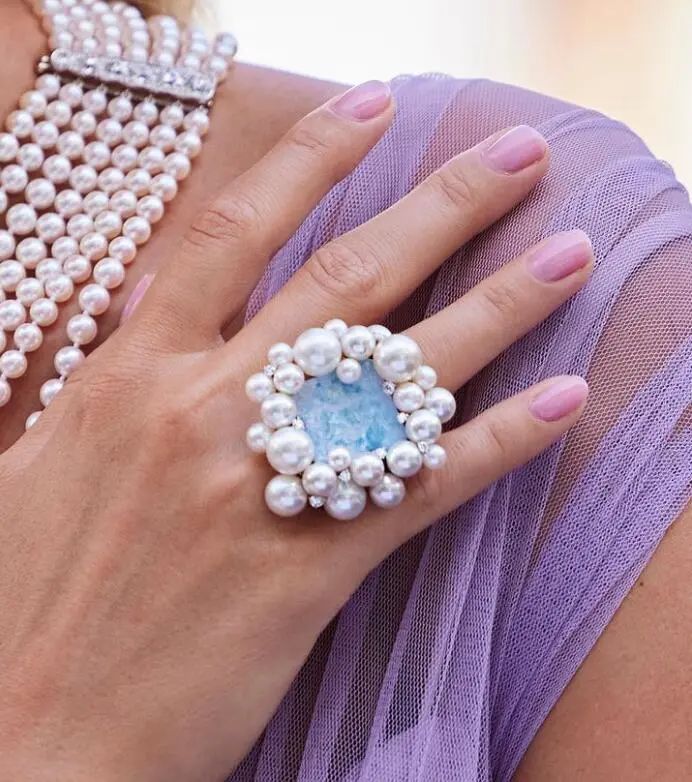
Akoya pearls, aquaprase, diamonds
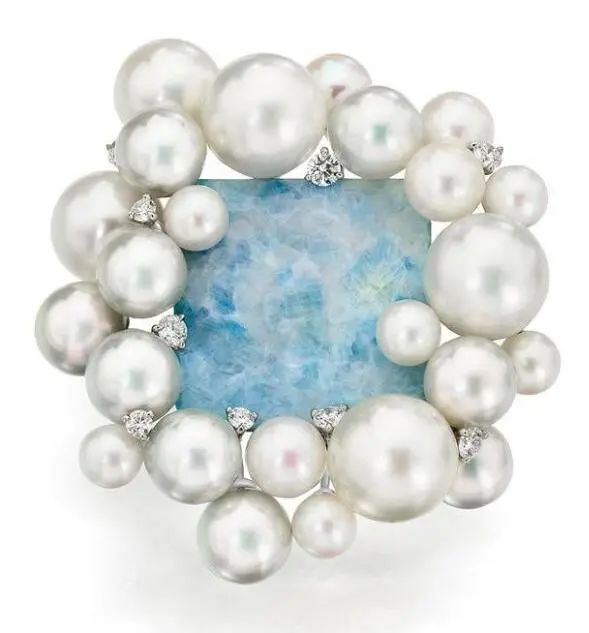
Akoya pearls, aquaprase, diamonds
Additionally, this designer often draws inspiration from Chinese culture. Previously, she liked to combine jade flower pieces with various pearls, but this year she discovered Maligano Jasper. Despite sharing a name with the jade from Hotan, its appearance is vastly different.
This special jasper from Indonesia, formed in ancient volcanic hot spring areas, is renowned for its contrasting blue and gray warm tones and its fascinating pictorial patterns.
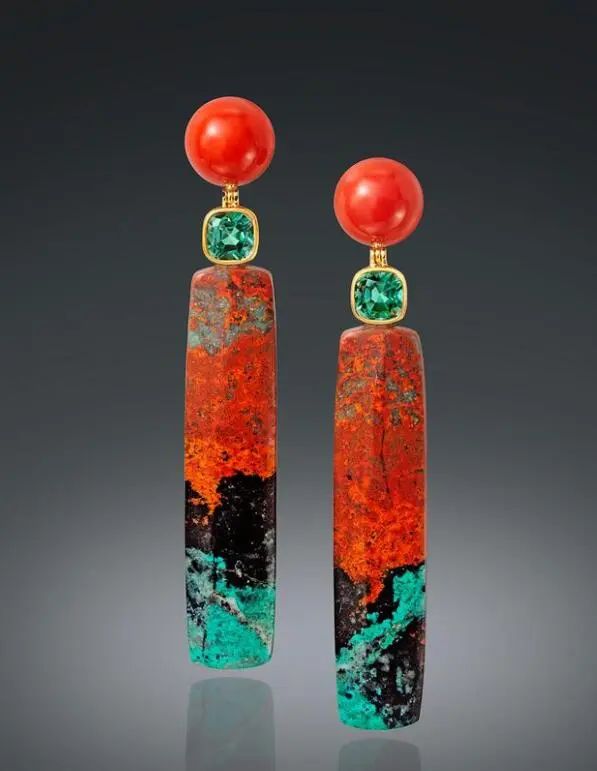
Coral, Maligano Jasper, tourmaline

Peggy Grosz first captured the magical colors and patterns of this gemstone, with the key being to choose gemstones of the same color as Maligano Jasper for pairing.
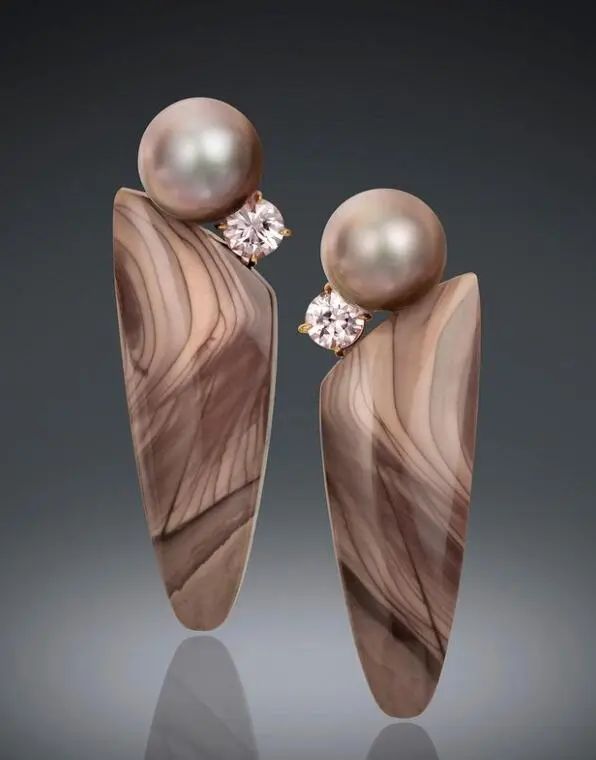
Tahitian pearls, Maligano Jasper, spinel

Soon, she discovered a beauty reminiscent of Chinese paintings in this gemstone. Especially when paired with coral and pearls, Maligano Jasper looks like a framed, natural flower-and-bird painting.
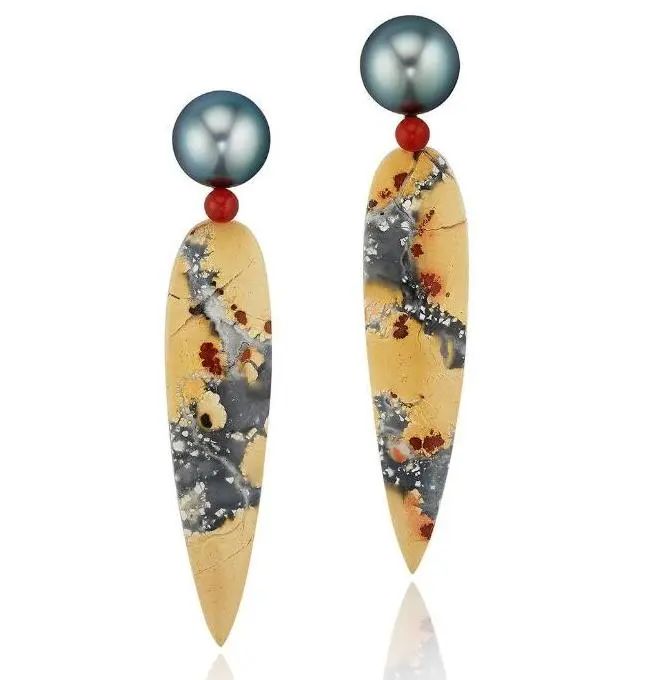
Coral, Maligano Jasper, Tahitian pearls
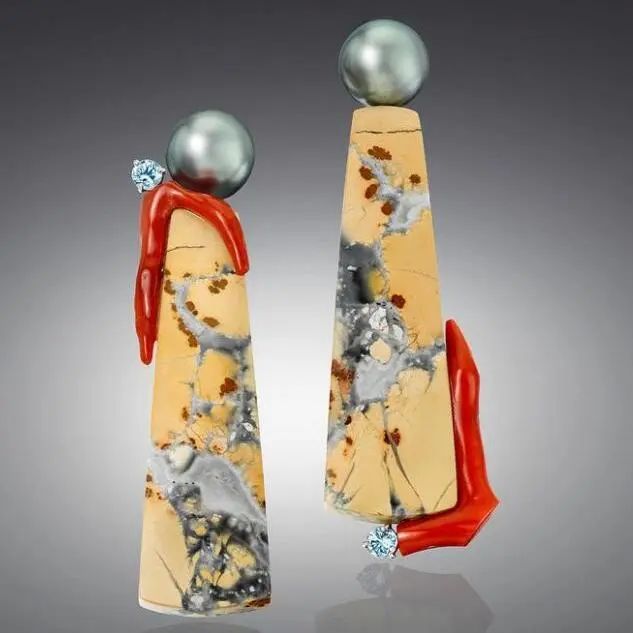
Tahitian pearls, coral, Maligano Jasper, tourmaline
Besides these unfamiliar “new faces,” Peggy Grosz also selects some familiar but niche gemstones for pairing. For instance, tourmaline, a very popular gemstone material in the high jewelry circle. However, her usage differs from other designers; she prefers to use bi-color tourmaline to echo the unique iridescent effect of pearls.

Akoya pearls, bi-color tourmaline
Peggy Grosz meticulously selects her pairings because she wants to showcase the state of color change. Especially the subtle color variations of Tahitian pearls, which under her skillful arrangement, are accentuated by the bi-color tourmaline.
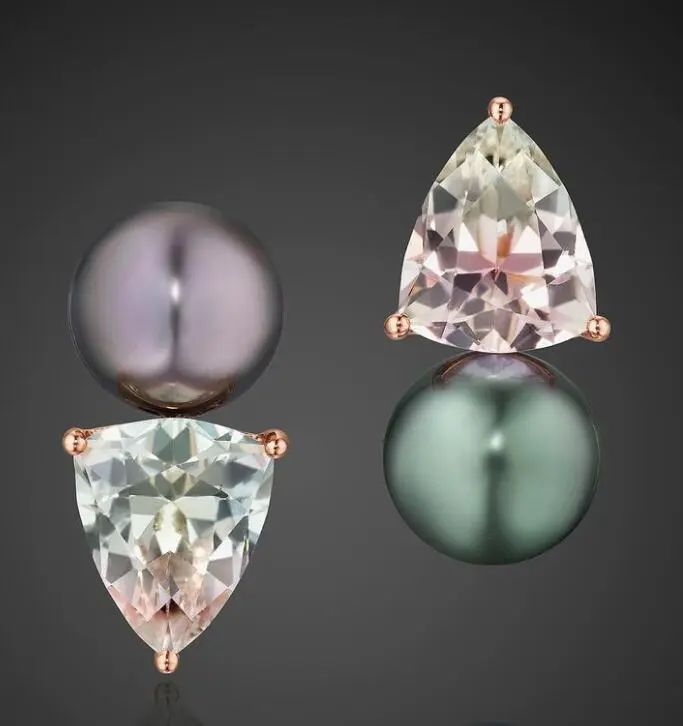
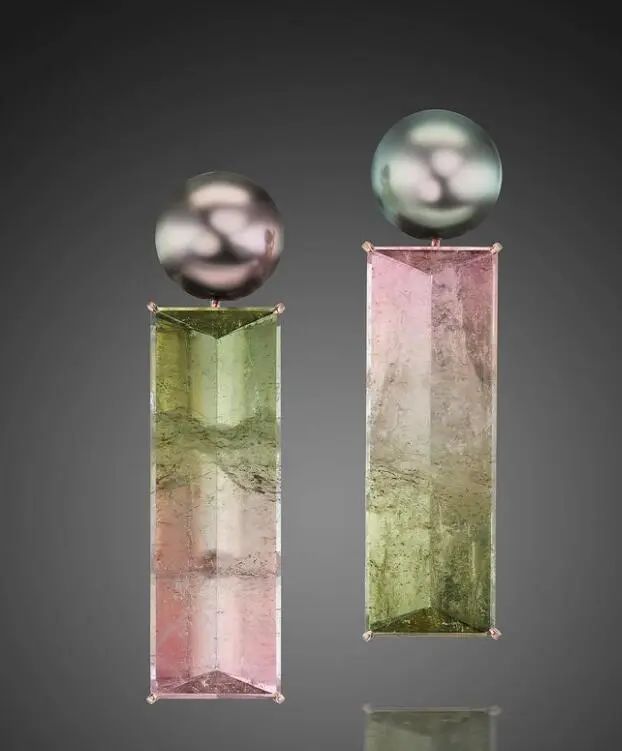
Tahitian pearls, bi-color tourmaline
Hemmerle’s Imitation of Natural Colors is Unparalleled
The German jewelry brand Hemmerle, though niche, is well-known among many jewelry collectors. It may not be mainstream, but its style can be described as unique. Hemmerle is adept at drawing inspiration from nature and historical culture, with an extraordinarily wide range of material choices.
Particularly noteworthy is their control over metal colors; bronze, iron, aluminum, and other non-mainstream jewelry metals are all favored because Hemmerle requires precise colors to achieve the realistic effect of their naturalistic works.

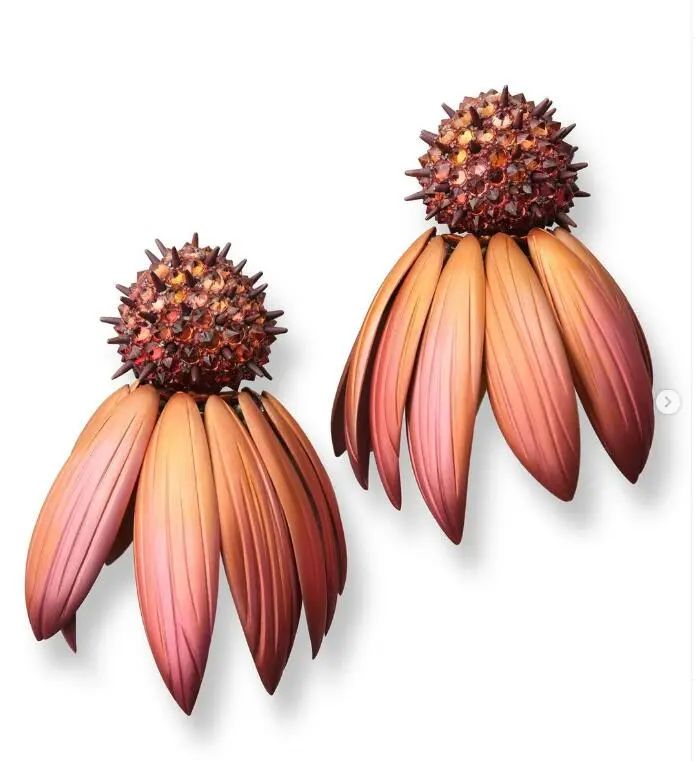
Copper, platinum, sapphires
Hemmerle can combine diamonds and the “classic three treasures” with iron, aluminum, and copper, and can also introduce pebbles, azurite, and wood into high jewelry design. But what unifies these vastly different materials is their superior alloy coloring technique.
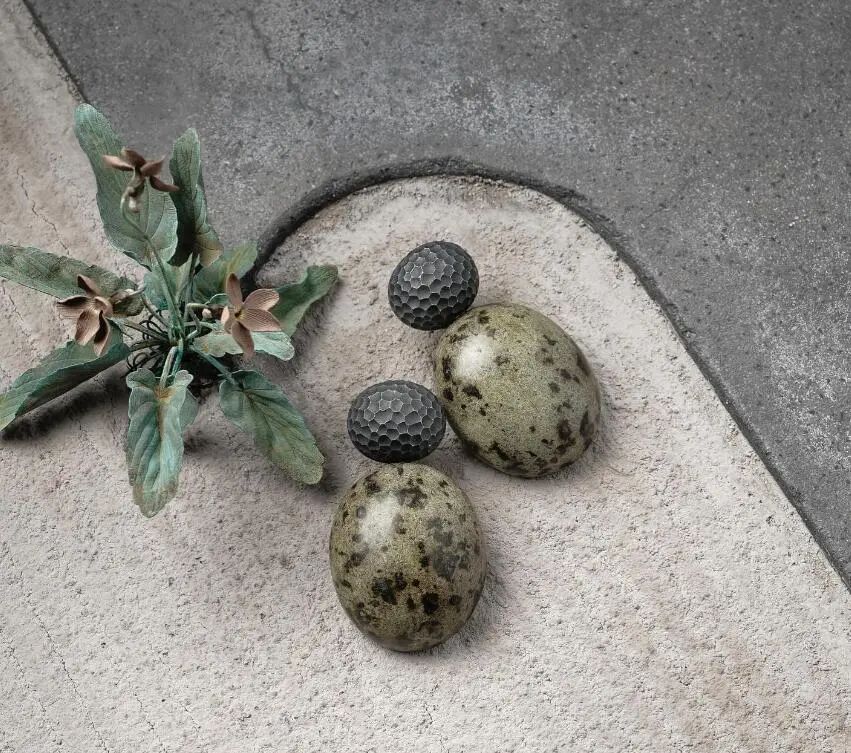
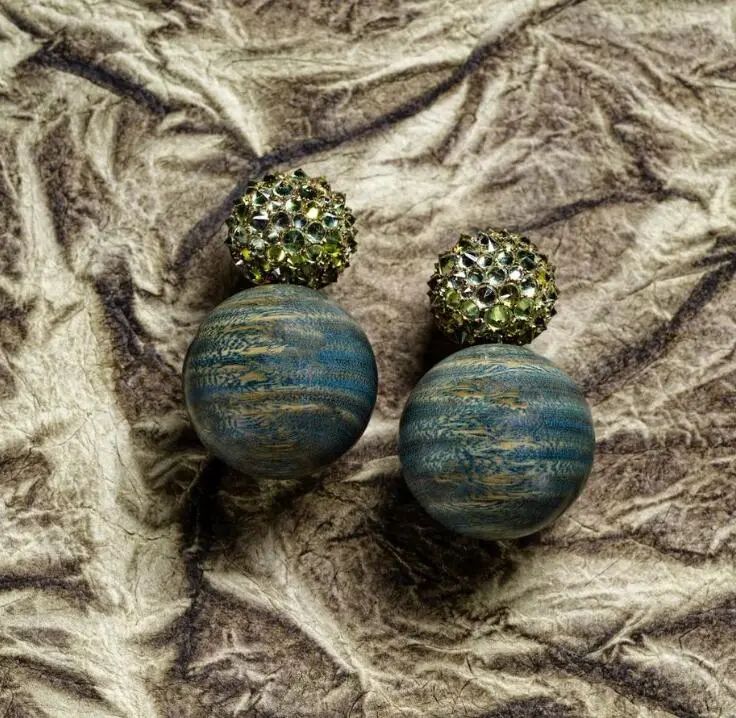
Bronze, platinum, green sandalwood, garnets
Metal is the framework and tone of Hemmerle jewelry, as well as an effective means of pursuing ultimate colors.
Hemmerle knows the characteristics of each metal intimately and knows how to process them to meet the needs of each piece of jewelry. Without exaggeration, Hemmerle’s metal colors are richer than most jewelry brands, as most designers limit their metal use to gold, silver, aluminum, and titanium. But for Hemmerle, these few metals are not enough to showcase nature’s rich tones.
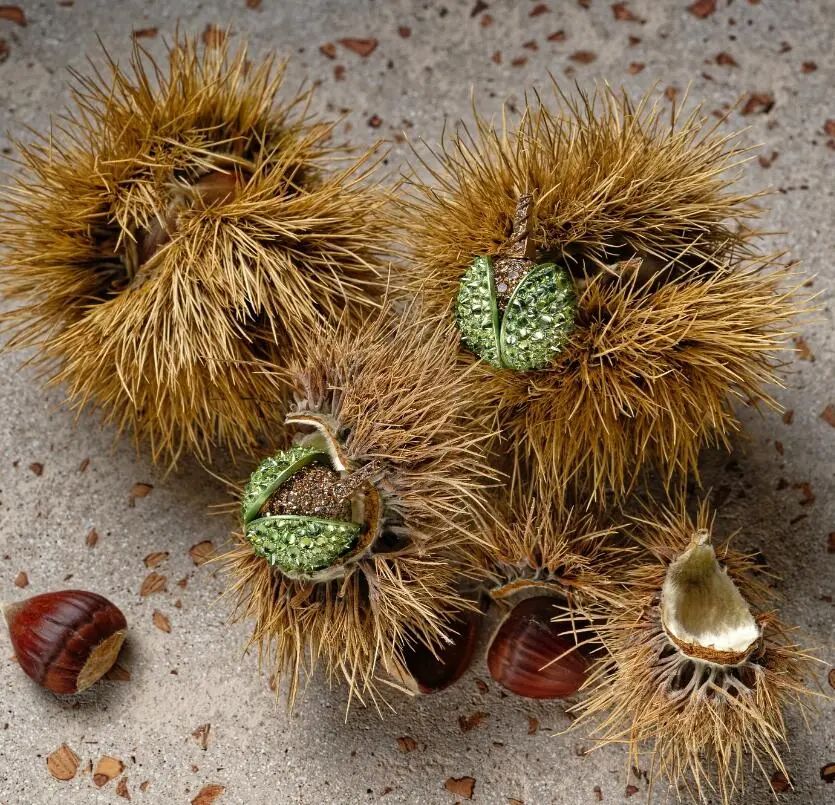
Aluminum, copper, platinum, diamonds, garnets
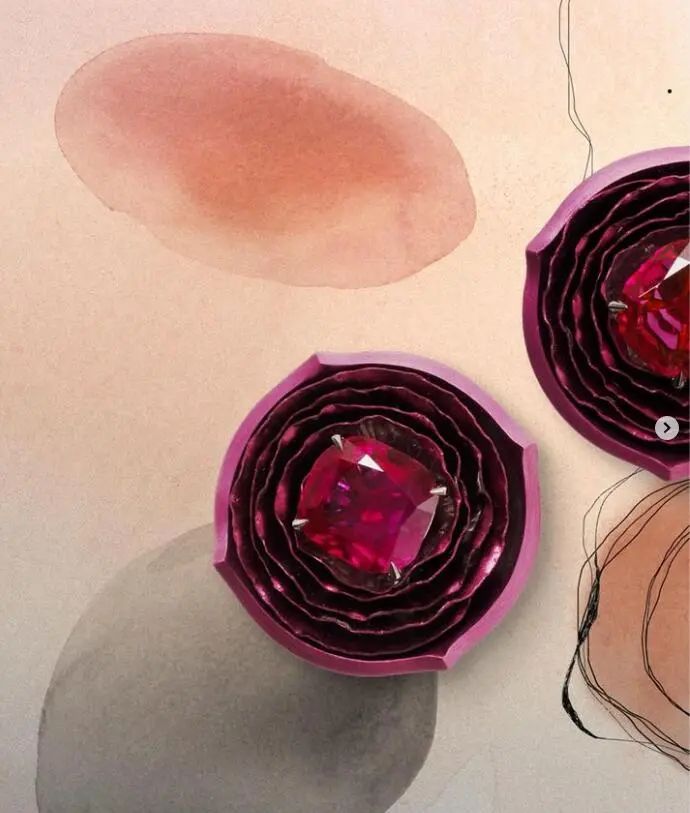
Aluminum, platinum, rubies
They can use copper to meticulously depict the fragility of leaves gradually withering as flowers fall and fruits form. The color is perfectly captured, especially when set against vibrant emeralds, presenting a sense of nature’s life cycle.
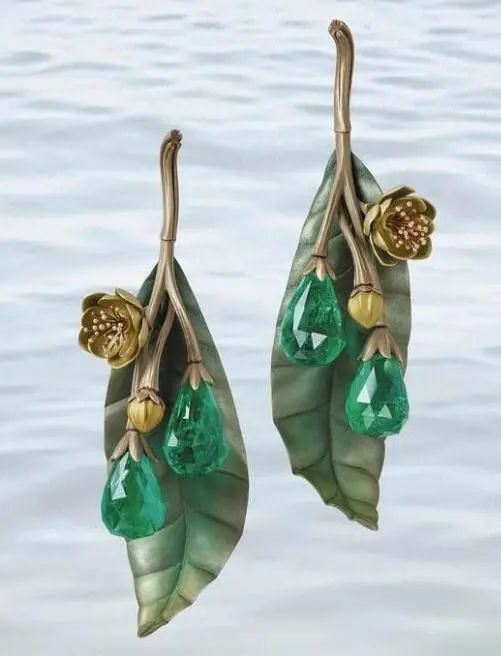
Platinum, carved aluminum, emeralds
They can also custom-blend matching green alloys for Chinese-style jade discs. This way, under the contrast of brilliant tourmalines and garnets, the metal framework not only doesn’t appear out of place but can also harmonize the stylistic differences between Eastern and Western gemstones.
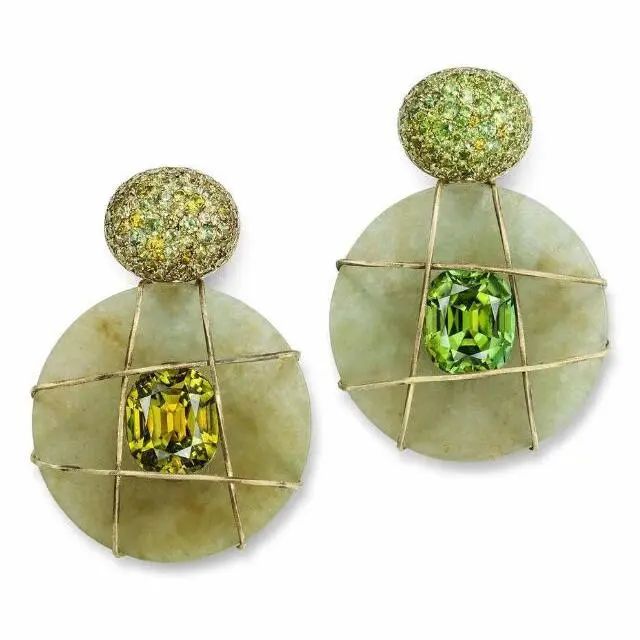
Green gold, jade disc, tourmaline, garnets
They can use metals to simulate various colors of nature, and with superior carving techniques, achieve both form and spirit, making it hard to distinguish between real and fake. For example, their previously launched “Herbal Tea” series truly blurs the line between reality and imitation.
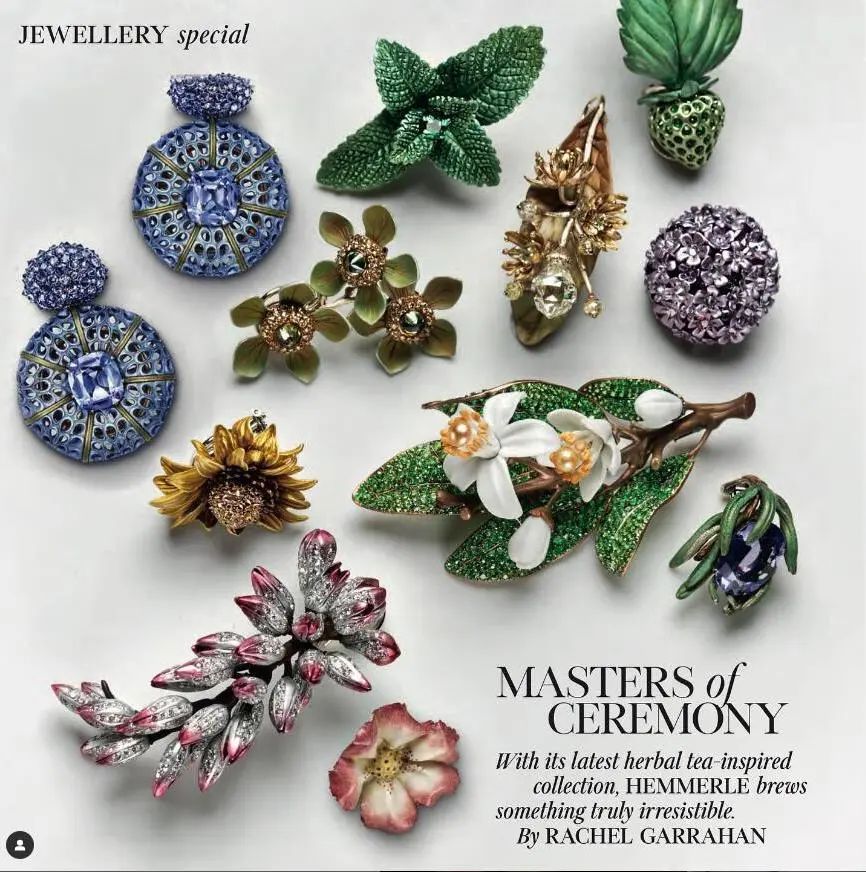
Some jewelry designers like to introduce new materials, which often requires superior craftsmanship or technological power to support these new materials. In their hands, mixing and matching is taken to the extreme because everything is possible. The niche gemstones they “appoint,” no matter how obscure before, can immediately shine brilliantly!
The “Great Magician’s” Skill Makes Everything Possible as Jewelry
When it comes to groundbreaking material innovation, we must mention Boucheron! Creative Director Claire Choisne can be considered a pioneer in mixing materials, from romantic and fragile flower petals and butterfly wings to ubiquitous marble and ceramics, all of which can become her creative materials. She is a typical “great magician who turns the ordinary into the extraordinary.” In her hands, nothing is impossible, and everything can become jewelry that transcends time.
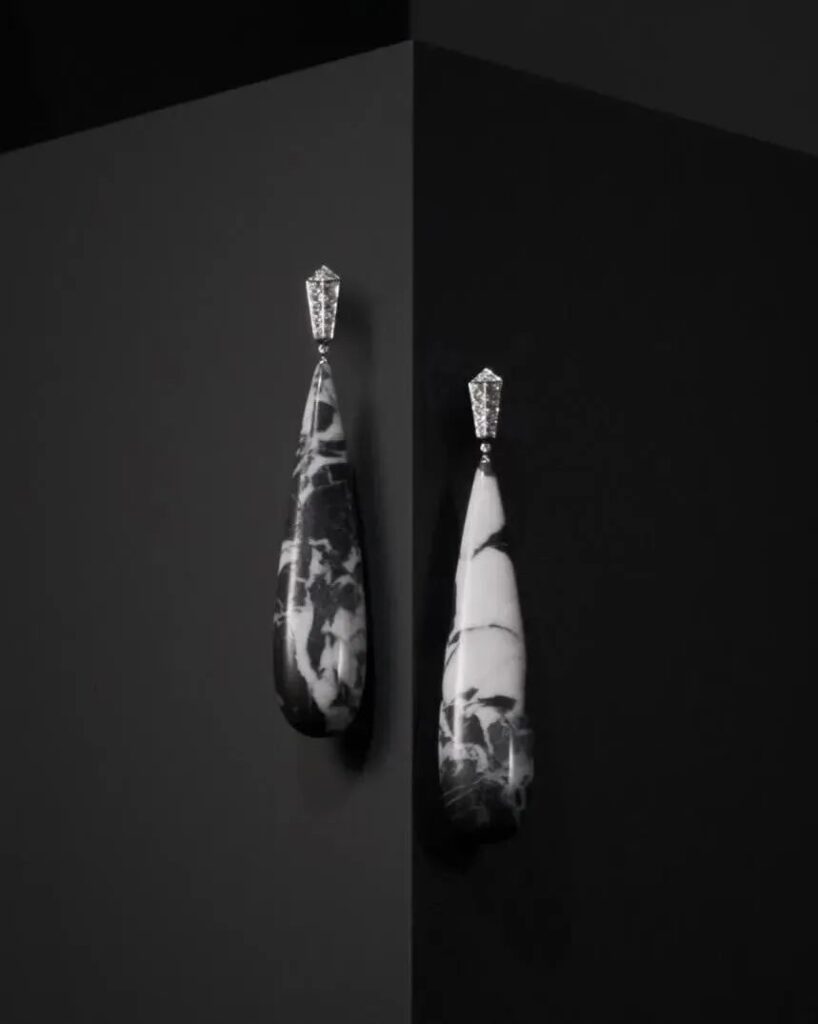
Carte Blanche, Or Bleu High Jewelry Collection
Banquise Pendant Earrings
White gold, Grand Antique marble, diamonds
This designer’s secret might be her precise grasp of atmosphere. The entire series exists to echo and reinforce each other, and her principle for material selection is just three words: “most suitable.” Perhaps she is also the designer with the least “sectarianism” in the high jewelry circle. In her eyes, gemstones are not classified by market value, but rather by which can best present the image in her mind.
For example, crystal, which is now thriving in the high jewelry circle, owes much to Claire Choisne. She loves the versatility of this gemstone – transparent, translucent, smooth, carved – it can present so many forms and is compatible with all gemstones. Although in value, crystal may be far from the “classic three treasures,” in Claire Choisne’s works, it is an indispensable role.
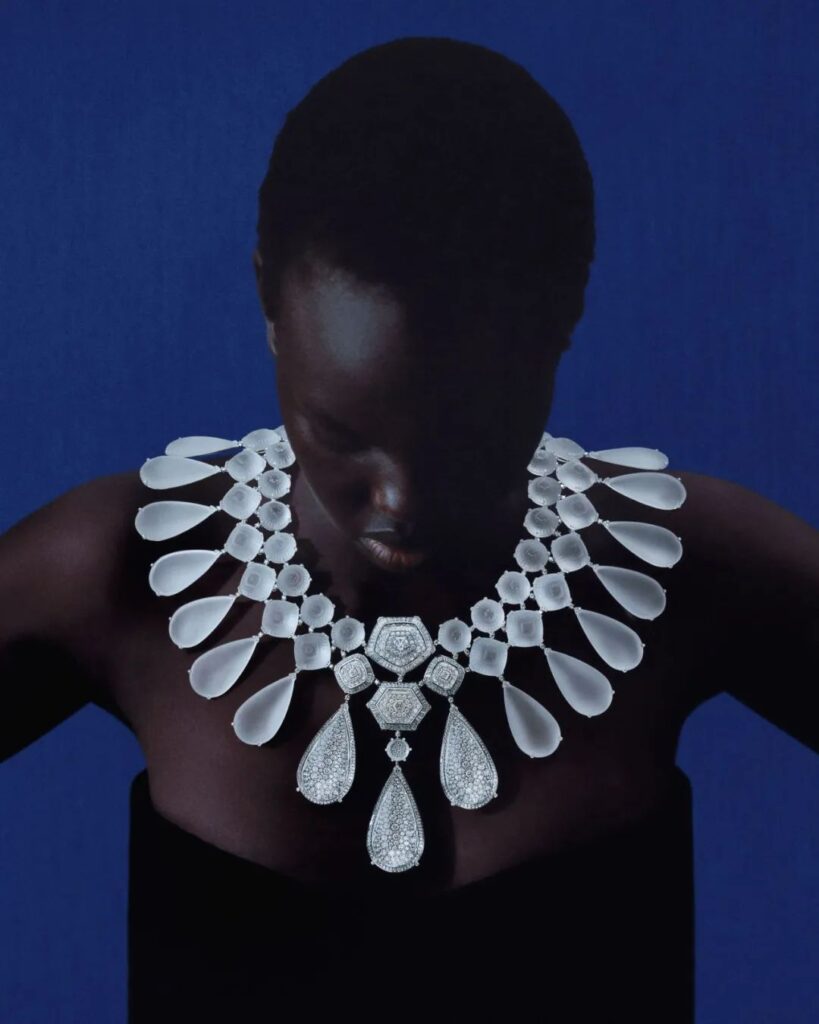
Carte Blanche, Or Bleu High Jewelry Collection
Iceberg Necklace
White gold, crystal, diamonds
Of course, Claire Choisne’s boldness in introducing these niche materials into the high jewelry circle is not just due to creativity, but mainly relies on advanced “black technology.”
Because her designs often break through in form, she needs superior jewelry craftsmanship to realize them. Whether it’s cutting-edge scientific technology or long-inherited craftsmanship, they all become means for her to realize her dreams. It’s precisely under the empowerment of these techniques that even not-so-expensive materials become worth a hundred times more.
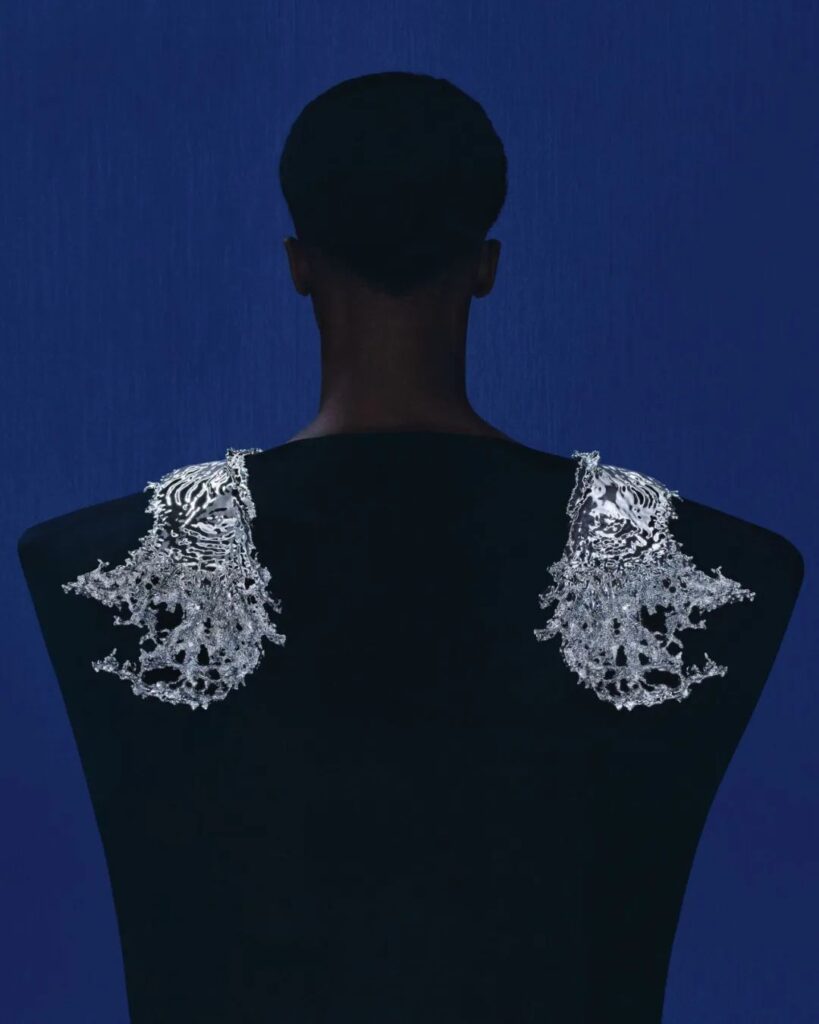
Carte Blanche, Or Bleu High Jewelry Collection
Eau Vive Shoulder Ornament
3D printed aluminum, palladium gold, diamonds
For example, the recently launched Carte Blanche, Or Bleu high jewelry collection uses many new materials. Claire Choisne pairs diamonds with obsidian, crystal, and marble to carve out different states of water. The Eau d’Encre bracelet combines 3D simulated wave-patterned obsidian with pavé diamonds, creating the mystery and grandeur of Iceland’s dark seas.
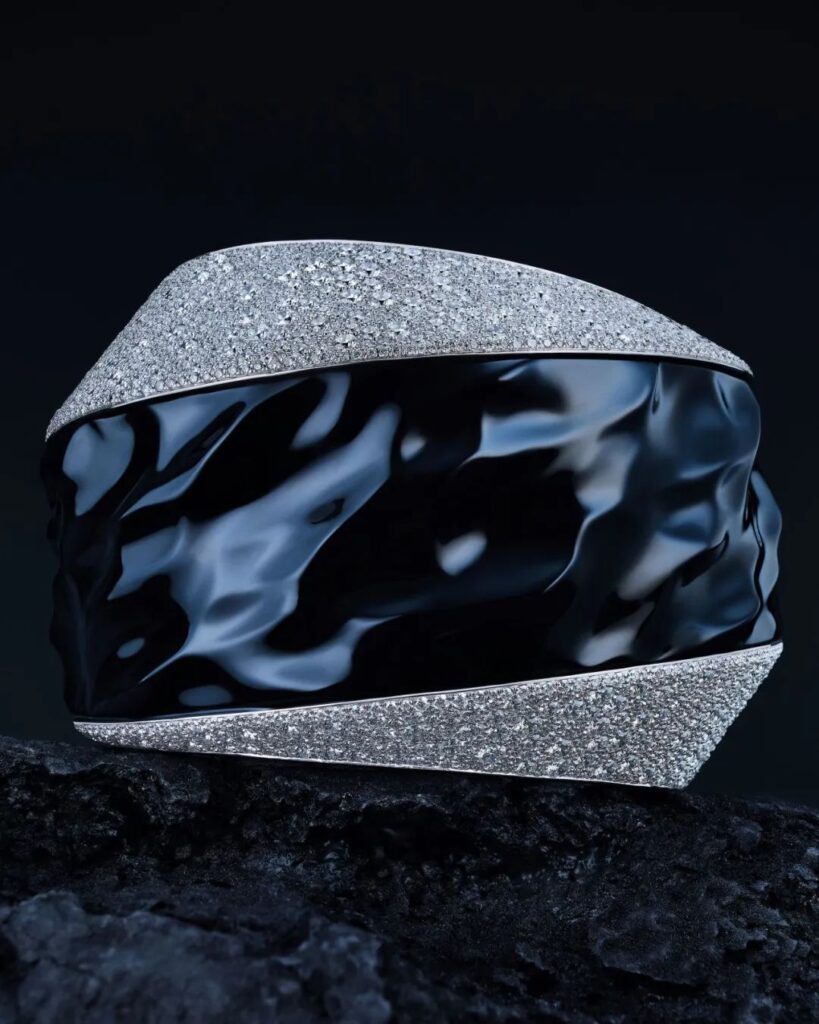
Carte Blanche, Or Bleu High Jewelry Collection
Eau d’Encre Bracelet
White gold, obsidian, diamonds
The Eau Forte bracelet and Sable Noir bracelet are inspired by the surging waves on black sand beaches, combining traditional French relief technique “eau-forte” with advanced 3D printing technology to outline a three-dimensional, richly varied realistic effect.
The Eau Forte bracelet creates visual contrast with pavé diamonds and black ink, while the Sable Noir bracelet applies black sand grains in jewelry, meticulously simulating nature’s spectacle from color to texture against the contrast of brilliant pavé diamonds.
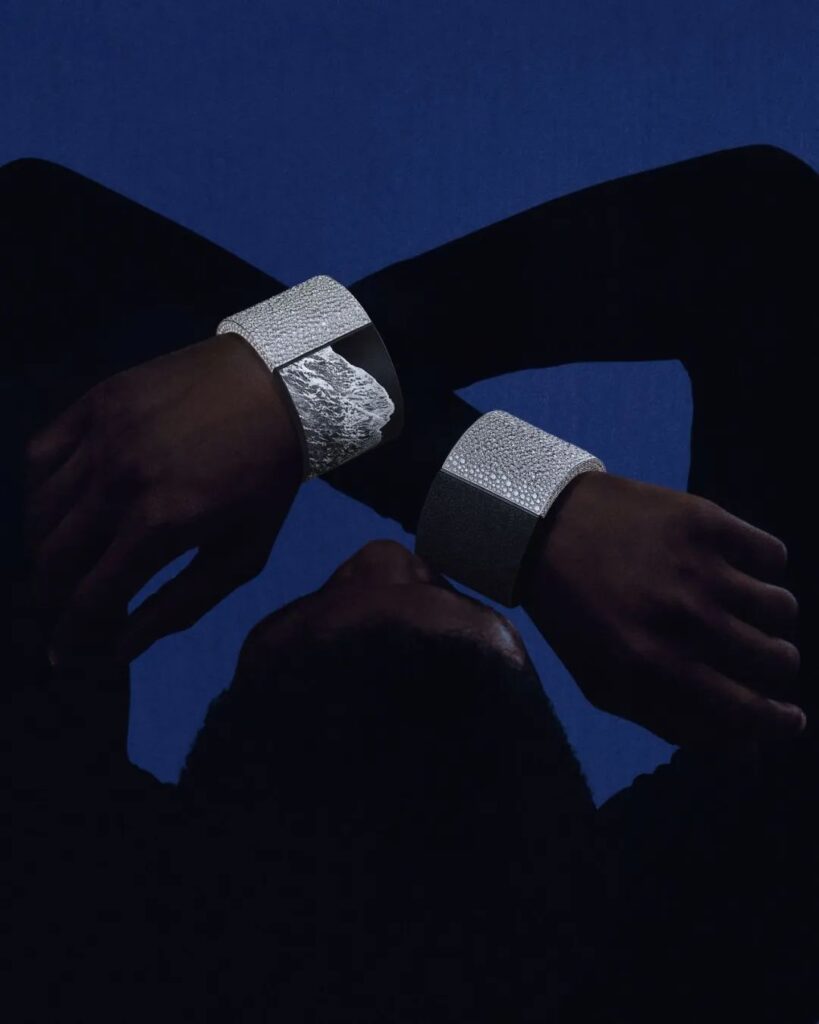
Carte Blanche, Or Bleu High Jewelry Collection
Eau Forte Bracelet
White gold, diamonds, decorated with black ink
Sable Noir Bracelet
Black sand, white gold, diamonds
Setting Technique Showcase: They Intensify “Intimacy”
There’s another group of players who try every means to increase the “intimacy” of various gemstone combinations. Yes, these are the players of the overlapping setting style. Relying on their excellent setting skills, they can combine gemstones seamlessly, making people feel at first glance that it’s a complete “new gemstone,” yet presenting a stunning effect of multiple colors and textures.
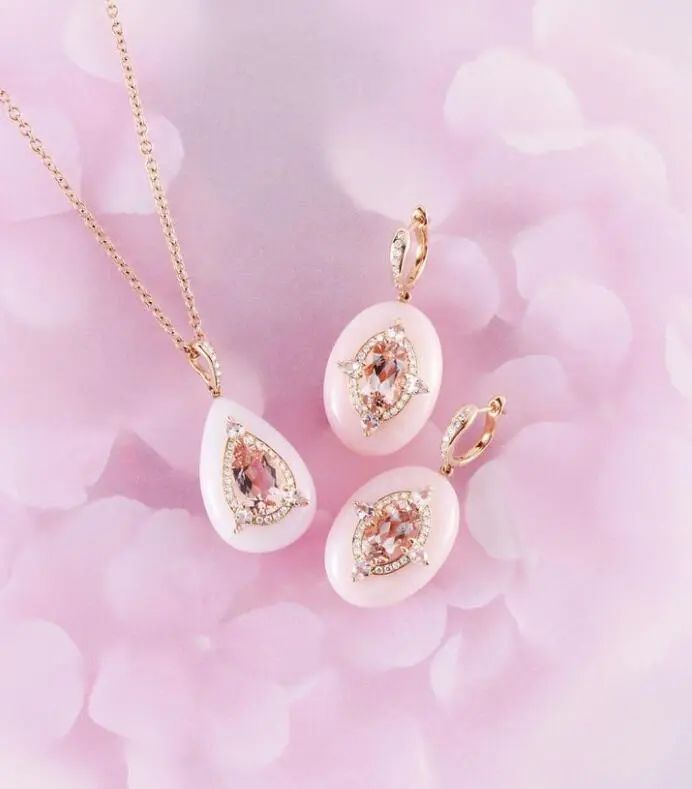
Pink opal, diamonds, morganite
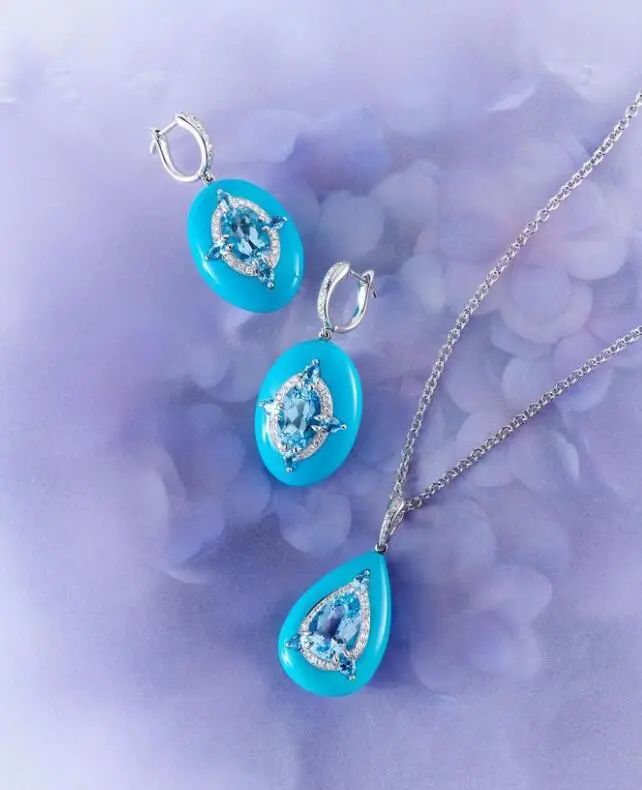
Turquoise, diamonds, topaz
The most representative brand is undoubtedly Boghossian, which invented the “Kissing” overlapping setting technique. They can freely “elevate” niche gemstones. They set diamonds in morganite, combine moonstone with pink diamonds, making them completely inseparable. This dazzling technique and design make even gemstones of slightly lesser value become unattainable.
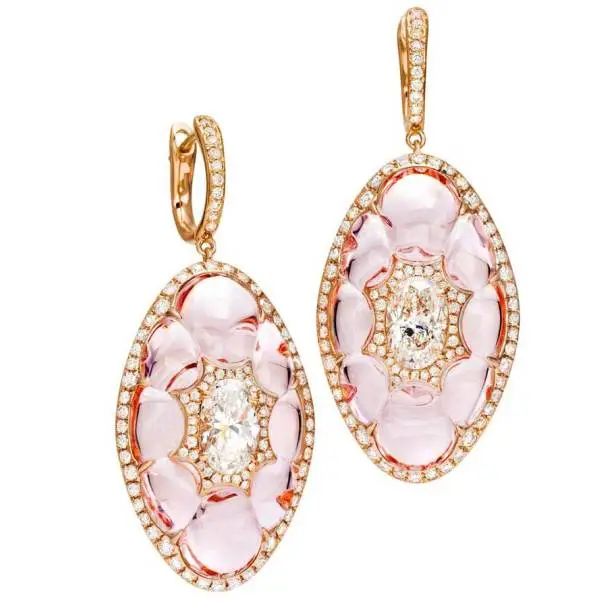
Diamonds, morganite
You thought combining two gemstones was enough? Boghossian’s showing-off knows no bounds. The Inlay series is all about layering, focusing on the charm of mixing multiple materials.
For instance, this ring is truly one layer within another. At its center is a diamond, set within a Paraiba tourmaline, which is then set in a teardrop-shaped turquoise, and finally bordered with diamonds. The entire ring alternates between brilliance, transparency, subtlety, and radiance.
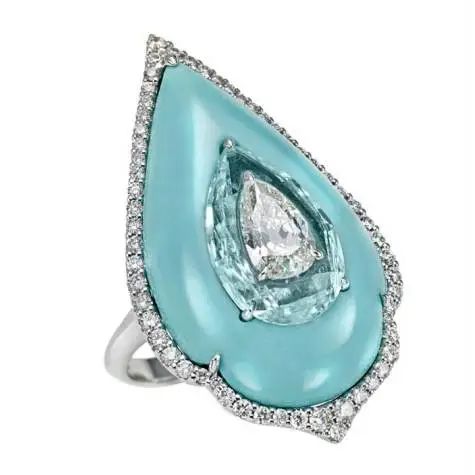
Paraiba tourmaline, diamonds, turquoise
Boghossian loves to delve deep into the dimension of transparency. Transparent, translucent, opaque – bringing rich variations in texture that complement each other. Thus, they often choose to layer gemstones of the same color family but with different textures.
For example, this necklace combines turquoise with Paraiba tourmaline, diamonds with chalcedony and crystal, creating light and dark variations, making the brilliant more brilliant and the elegant more elegant.
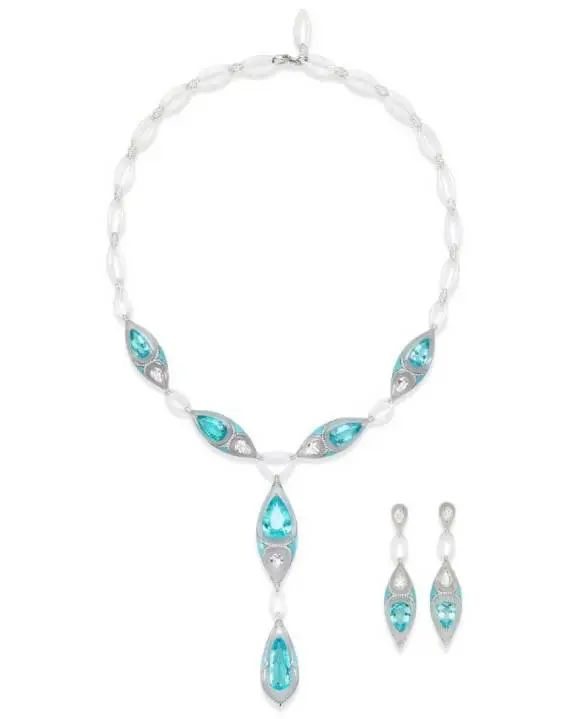
Paraiba tourmaline, crystal, turquoise, diamonds, chalcedony
Since Boghossian took the lead in playing with overlapping settings, many designers have been inspired to start this de-metallized gemstone mixing. Emily P. Wheeler is very skilled at setting center stones in other precious gemstones, but unlike Boghossian, she doesn’t pursue delicate changes, preferring instead a strong contrast approach.

Chubby Ring Series
She says, “I use the overlapping setting technique in many of my works. Although it’s very challenging and requires extremely high precision, sometimes requiring multiple attempts to get them to combine just right, the final effect is always surprising, as if touched by magic.”
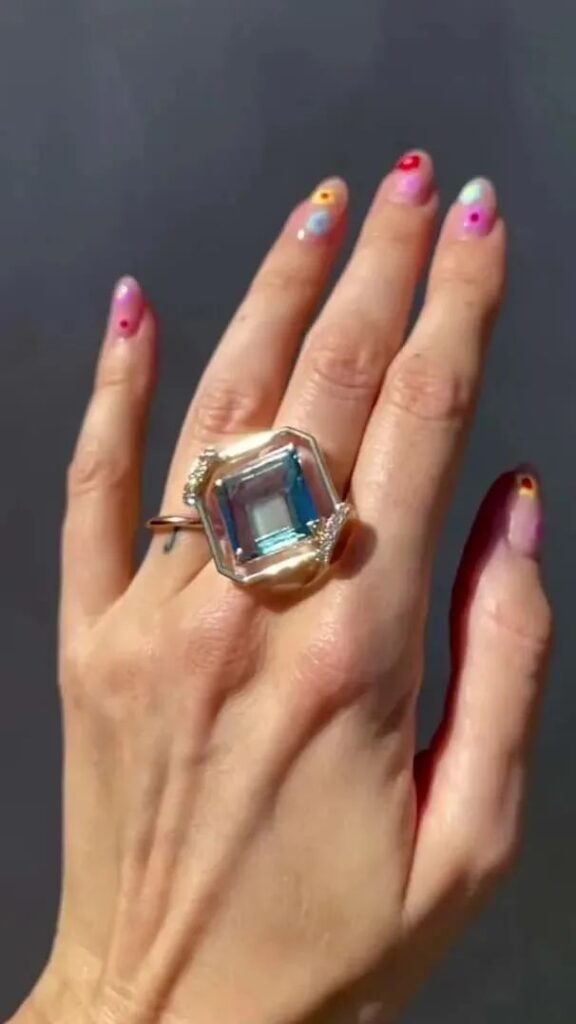
Sapphire, crystal, diamonds
However, her inspiration comes from another jewelry designer, Nicholas Varney, who is her jewelry idol. In an interview, she said that the first piece of jewelry she fell in love with was a ring designed by Nicholas Varney.

Yes, Nicholas Varney loves mixing materials. He combines precious metals, rare natural pearls, and colored gemstones with wood, cork, eggshells, and coral, giving his works a whimsical beauty that perfectly balances his minimalist modern style.
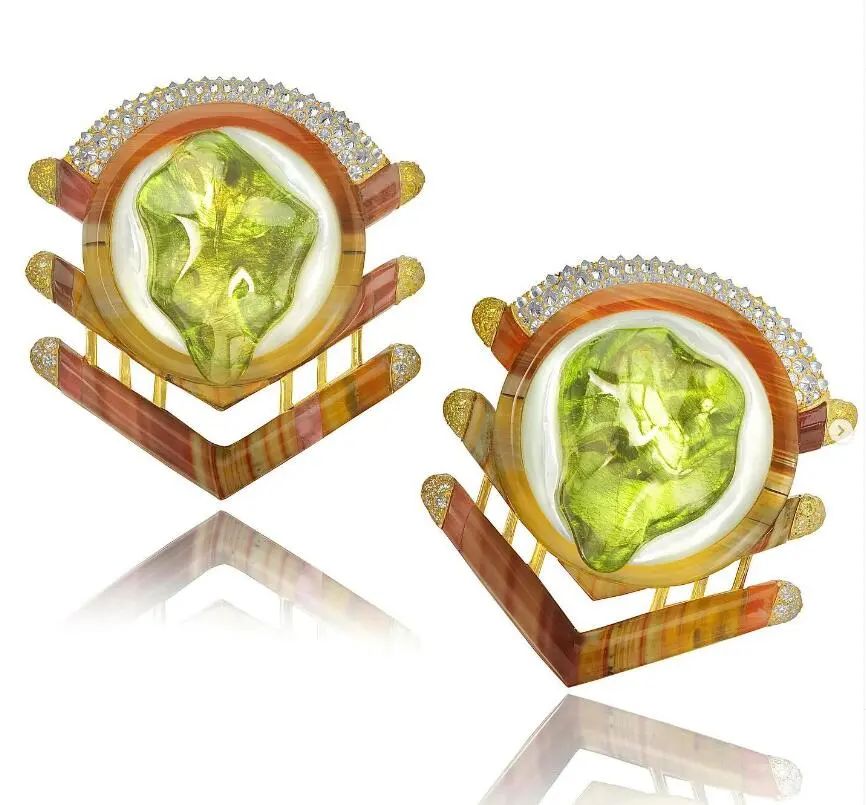
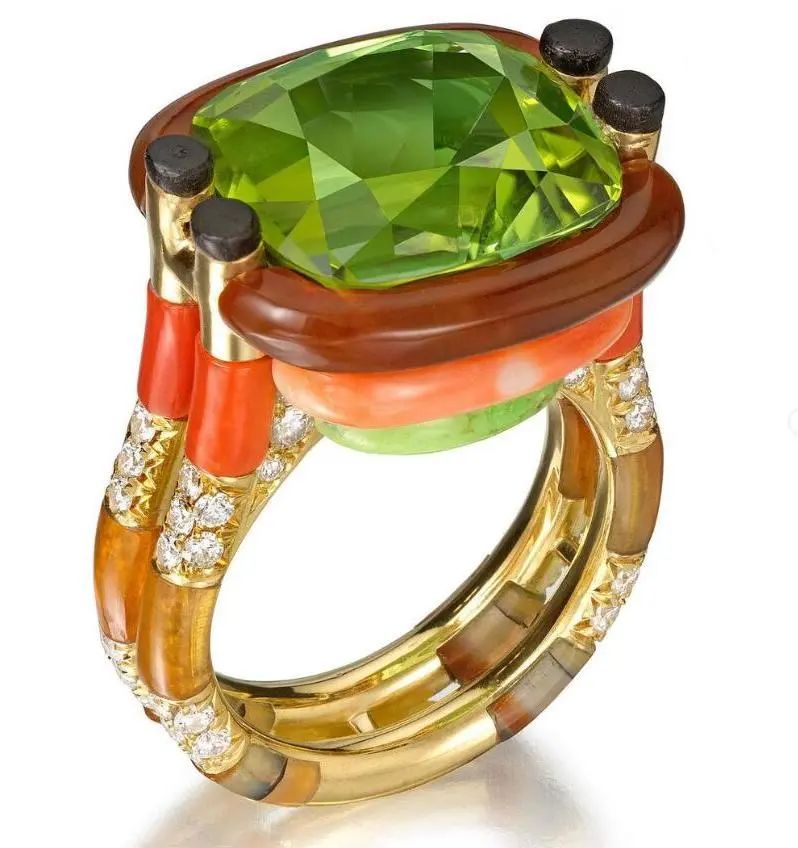
Diamonds, coral, agate
He particularly loves the patterns of agate – it’s definitely true love. Not only does he frequently use agate in his jewelry, but he also deliberately uses other gemstones to simulate agate patterns. He believes that the natural patterns of agate have a unique sense of rhythm, a natural “geometrism” created by nature.
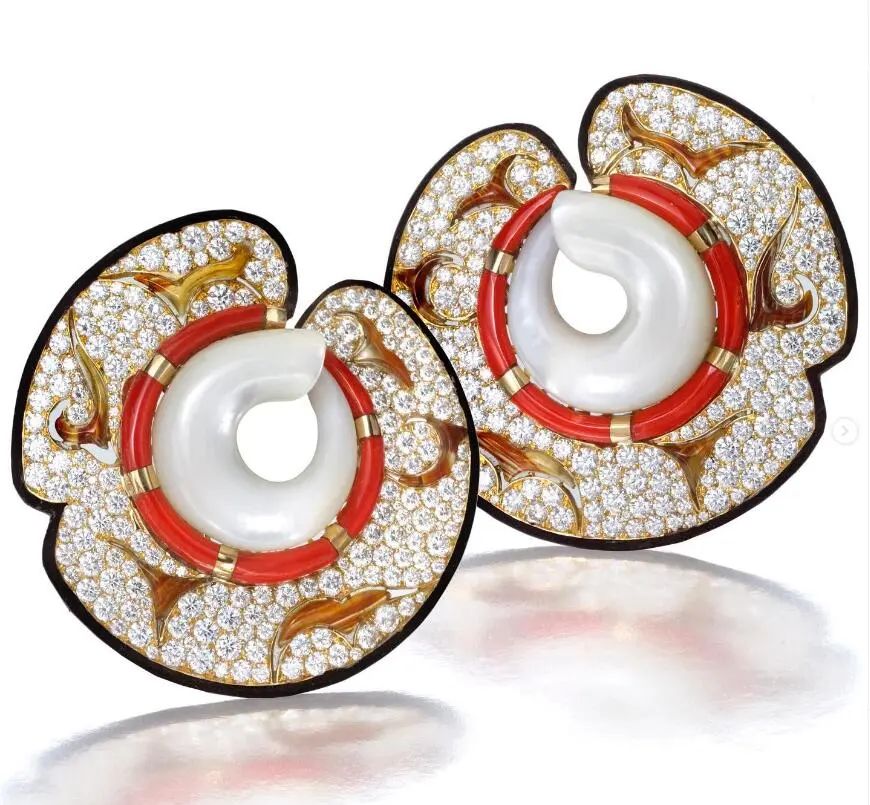
Mother-of-pearl, diamonds, wood, coral, banded agate
So in his hands, agate is not just an inexpensive “base material,” but a “main melody” that can be paired with any material. It can partner with turquoise, coral, diamonds, and even have rare demantoid garnets as its “foundation.”
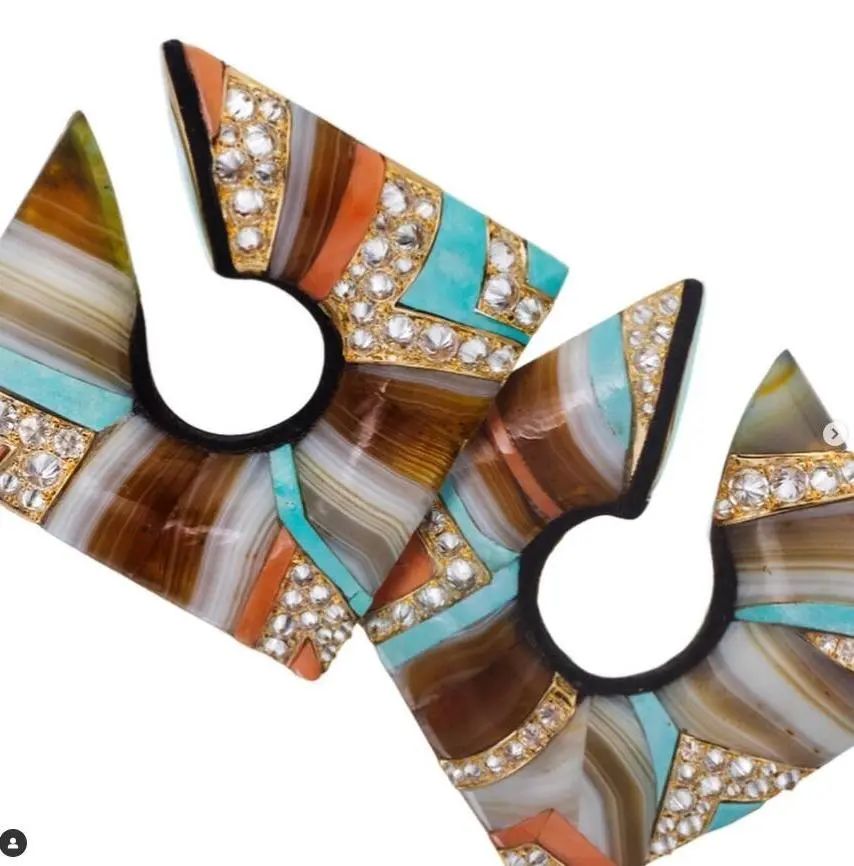
Agate, turquoise, coral, diamonds
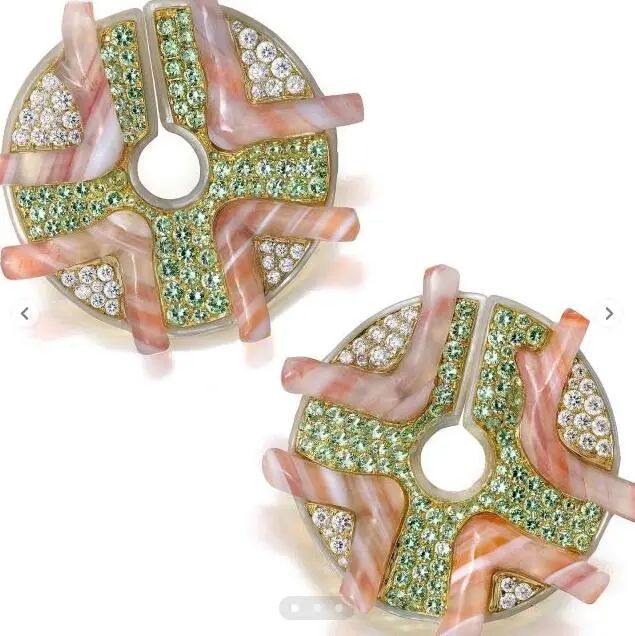
Mother-of-pearl, diamonds, agate, chalcedony, demantoid garnet
How about that? Isn’t it eye-opening? Of course, designing with all premium gemstones is high-end, but being able to increase the value of niche gemstones a hundredfold through design truly demonstrates the skill and courage of a real player.
Perhaps this is the value of jewelry designers – using creativity and craftsmanship to “turn the ordinary into the extraordinary”!
Jewelry Alchemists: How These Designers Turn Obscure Gems into Priceless Treasures!
Tweet

